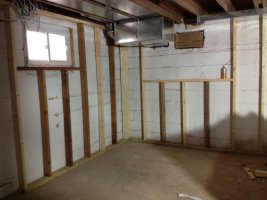twoply
Registered User
Hey everyone!
I'd like to discuss what is needed in this picture in regards to insulation/ vapor barrier.
This is a generic picture I pulled off the internet, but it represents what we run into around our Northern Ohio area.
The owner is self performing the work and wants to install foam board in the rim cavities and faced insulation in the walls.
The real question I have is about the need for vapor barrier. Is it necessary? And if so, where should it be installed?
It seems if you install the VB between the stud and drywall, moisture may move from the moist masonry wall into the wood studs and promote mold growth.
If you install the VB right on the masonry wall it may trap moisture against the masonry wall and never have a chance to dry and promote mold growth.
I'm arguing with myself even. Can I get a little help here?
I'd like to discuss what is needed in this picture in regards to insulation/ vapor barrier.
This is a generic picture I pulled off the internet, but it represents what we run into around our Northern Ohio area.
The owner is self performing the work and wants to install foam board in the rim cavities and faced insulation in the walls.
The real question I have is about the need for vapor barrier. Is it necessary? And if so, where should it be installed?
It seems if you install the VB between the stud and drywall, moisture may move from the moist masonry wall into the wood studs and promote mold growth.
If you install the VB right on the masonry wall it may trap moisture against the masonry wall and never have a chance to dry and promote mold growth.
I'm arguing with myself even. Can I get a little help here?

